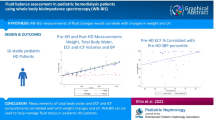Abstract
Background
In recent years, bioimpedance analysis has come to be widely used in clinical practice for dialysis patients, but there is not sufficient consensus on its significance. We aimed to examine the merits of performing bioimpedance analysis in addition to conventional evaluation methods for dry weight such as measuring human atrial natriuretic peptide (hANP), blood pressure, and cardiothoracic ratio in patients on chronic hemodialysis.
Methods
Body composition of 78 hemodialysis patients was performed by using a new and more accurate segmental multifrequency bioimpedance analysis device (Seca® medical body composition analyzer 525, Seca GmbH & Co. KG, Hamburg, Germany). Laboratory data including hANP at post-dialysis and demographic profile were collected. Statistical analysis was performed with SPSS software.
Results
Mean age of the patients was 66.9 ± 12.6 years and 80.8% were males. Mean value of hANP and the ratio of extracellular water to total body water (ECW/TBW) were 61.4 ± 36.4 pg/mL and 46.1 ± 3.9%, respectively. The calculated ECW/TBW cutoff point for hANP > 50 pg/mL was 45.0%, with sensitivity of 74.4% and specificity of 64.7%. Patients with an ECW/TBW of more than 45% and hANP value of > 50 pg/mL had a higher blood pressure and cardiothoracic ratio on chest X-ray examination.
Conclusions
Our results suggest that the ratio of extracellular water to total body water of more than 45% and hANP value of ≥ 50 pg/mL were overhydrated in chronic hemodialysis patients. Whether monitoring levels of these parameters has a role in the outcome including patients’ survival and cardiovascular events requires further study.

Similar content being viewed by others
Availability of data and materials
Not applicable.
References
Wizemann V, Wabel P, Chamney P, et al. The mortality risk of overhydration in haemodialysis patients. Nephrol Dial Transplant. 2009;24:1574–9.
Dekker MJ, Marcelli D, Canaud BJ, et al. MONDO Ini- tiative. Impact of fluid status and inflammation and their interaction on survival: a study in an international hemodialysis patient cohort. Kidney Int. 2017;91:1214–23.
Zoccali C, Moissl U, Chazot C, et al. Chronic fluid overload and mortality in ESRD. J Am Soc Nephrol. 2017;28:2491–7.
Bosy-Westphal A, Schautz B, Later W, et al. What makes a BIA equation unique? Validity of eight-electrode multifrequency BIA to estimate body composition in a healthy adult population. Eur J Clin Nutr. 2013;67(Suppl 1):S14–21.
Sivalingam M, Vilar E, Mathavakkannan S, et al. The role of natriuretic peptides in volume assessment and mortality prediction in haemodialysis patients. BMC Nephrol. 2015;16:218.
Io H, Nakata J, Inoshita H, et al. Relationship among left ventricular hypertrophy, cardiovascular events, and preferred blood pressure measurement timing in hemodialysis patients. J Clin Med. 2020;9:3512.
Amari Y, Morimoto S, Iida T, et al. Association between serum soluble (pro)renin receptor level and worsening of cardiac function in hemodialysis patients: a prospective observational study. PLoS One. 2020;15:e0233312.
Sukackiene D, Laucyte-Cibulskiene A, Vickiene A, et al. Risk stratification for patients awaiting kidney transplantation: role of bioimpedance derived edema index and nutrition status. Clin Nutr. 2020;39:2759–63.
Zhou Q, Wang J, Xie S, et al. Correlation between body composition measurement by bioelectrical impedance analysis and intradialytic hypotension. Int Urol Nephrol. 2020;52:953–8.
Hur E, Usta M, Toz H, et al. Effect of fluid management guided by bioimpedance spectroscopy on cardiovascular parameters in hemodialysis patients: a randomized controlled trial. Am J Kid Dis. 2013;61:957–65.
Onifriescu M, Siriopol D, Voroneanu L, et al. Overhydration, cardiac function and survival in hemodialysis patients. PLoS One. 2015;10:e0135691.
Hung SC, Kuo KL, Peng CH, et al. Volume overload correlates with cardiovascular risk factors in patients with chronic kidney disease. Kidney Int. 2014;85:703–9.
Yotsueda R, Taniguchi M, Tanaka S, et al. Cardiothoracic ratio and all-cause mortality and cardiovascular disease events in hemodialysis patients: the Q-cohort study. Am J Kidney Dis. 2017;70:84–92.
Inaba M, Karaboyas A, Akiba T, et al. Association of blood pressure with all-cause mortality and stroke in Japanese hemodialysis patients: the Japan dialysis outcomes and practice pattern study. Hemodial Int. 2014;18:607–15.
McIntyre CW, Goldsmith DJ. Ischemic brain injury in hemodialysis patients: which is more dangerous, hypertension or intradialytic hypotension? Kidney Int. 2015;87:1109–15.
Vriese AS, Tilton RG, Stephan CC, et al. Vascular endothelial growth factor is essential for hyperglycemia-induced structural and functional alterations of the peritoneal membrane. J Am Soc Nephrol. 2001;12:1734–41.
Funding
None.
Author information
Authors and Affiliations
Contributions
KW and MN originated the idea and designed the study. KW, YI, TF, MN and FT collected and analyzed data. KW and MN were responsible for writing the manuscript. All authors read and approved the final manuscript.
Corresponding author
Ethics declarations
Conflict of interest
The authors declare that they have no competing interests.
Ethics approval
This study was approved by the research ethics committee of St Luke's International Hospital (approval number 18-R013).
Consent to participate
Informed consent was obtained from all patients prior to enrollment in the study.
Consent for publication
Not applicable.
Additional information
Publisher's Note
Springer Nature remains neutral with regard to jurisdictional claims in published maps and institutional affiliations.
About this article
Cite this article
Watanabe, K., Ito, Y., Fujimaru, T. et al. Role of the new bioimpedance monitoring device (Seca®) in assessing dry weight in hemodialysis patients. Clin Exp Nephrol 26, 460–465 (2022). https://doi.org/10.1007/s10157-021-02177-7
Received:
Accepted:
Published:
Issue Date:
DOI: https://doi.org/10.1007/s10157-021-02177-7




